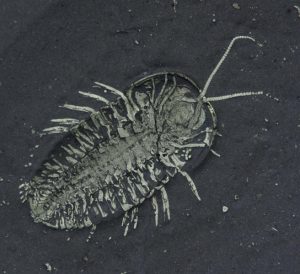
For the past two years, Western Illinois University Assistant Professor of Geology Thomas Hegna has been part of a three-member team conducting research on what are believed to be the first-ever discovered trilobite eggs paired with a fossil of the segmented creature.
The ancient eggs, believed to be about 450 million years old, were found in New York by Markus Martin, an amateur paleontologist and friend to Hegna. The team also includes Assistant Professor Simon Darroch of Vanderbilt University.
Hegna said trilobites most closely resemble modern “rolly-polly” bugs. The trilobites are fossilized inside black shale, which Hegna said likely happened as a result of them being forced out of their habitat by an event such as an undersea mudslide.
“They would have had to be buried quickly to have been preserved,” Hegna said.
Martin collected the rocks in New York and then cracked them in an effort to examine what was inside. The trilobites from this locality are replaced with the mineral pyrite. Hegna said if Martin saw pyrite, also known as fools gold, in the crack, he then used an air abrasion system to go through the layers to get down to the trilobite.
“After Markus showed me the pictures of what he found we had a ‘eureka’ moment,” said Hegna. “My first thought was ‘What else could they be?’ People have found trilobites before, but never found the actual animal and eggs together.”
As fossil invertebrates, trilobites lived exclusively in the ocean during the Paleozoic Era.
After conducting visual research on the unearthed trilobites, Hegna said the team used a micro CT scanner at Vanderbilt University to get a “flipbook of slices” through the preserved trilobites and eggs.
“We digitally dissected the fossils,” said Hegna. “The CT scans help us see if the eggs were attached to the body without disturbing the fossil. It helped verify the egg’s replacement relative to the trilobite.”
The three-member team collaborated to write up the results of their research into a paper that was recently published in the academic journal Geology.
The team also presented its findings at the Central Regional and National meetings of the Geologic Society of America. Hegna said the attention the presentations received helped confirm the findings the team had made through its research.
Prior to the team’s discovery, nothing was known about this early phase of the development of trilobites.
“By knowing more about their reproductive biology, we expand our knowledge about trilobite autecology and can begin to address long-standing research questions about trilobite mating behavior and reproductive strategies,” said the team’s paper. “Pyritized in situ trilobite eggs from the Ordovician of New York (Lorraine Group): Implications for trilobite reproductive biology.”
Many of the specimens that were part of the team’s research were donated to the Peabody Museum at Yale University, where Hegna completed his doctoral research. The museum also received the three-dimensional digital model of the specimens the team produced using the CT scan data.
Reference:
Thomas A. Hegna, Markus J. Martin, Simon A.F. Darroch. Pyritized in situ trilobite eggs from the Ordovician of New York (Lorraine Group): Implications for trilobite reproductive biology. Geology, 2017; G38773.1 DOI: 10.1130/G38773.1
Note: The above post is reprinted from materials provided by Western Illinois University.










